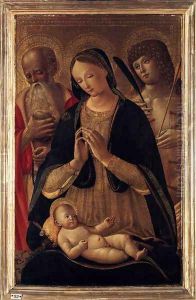Pietro di Domenico Da Siena Paintings
Pietro di Domenico da Siena, also known as Pietro di Domenico di Pietro, was a Sienese painter who was active during the Renaissance period. Born in 1457 in Siena, Italy, he is often associated with the Sienese School, which was known for its continuation of Gothic artistic traditions and resistance to the influences of the Florentine Renaissance that were sweeping Italy during the time.
Pietro's work is characterized by the use of bright colors, intricate decoration, and traditional Sienese elegance. He was primarily a religious painter, creating altarpieces, frescoes, and manuscript illuminations. However, not much is known about his training or early work. It is assumed that he was trained locally in Siena, possibly in the workshop of a more established artist such as Matteo di Giovanni or Francesco di Giorgio Martini, who were prominent Sienese artists of the time.
Throughout his career, Pietro di Domenico was influenced by the stylistic changes occurring in Italian art but remained loyal to the Sienese tradition. His works often featured elongated figures and were marked by their devotional intensity and attention to detail. One of his notable works is 'The Baptism of Christ,' which showcases his skill in handling narrative detail and his use of vibrant colors.
Despite his adherence to the Gothic style, Pietro's art also shows the impact of the Renaissance, particularly in his use of perspective and volume to create a sense of three-dimensionality in his figures. This blend of traditional and contemporary elements helped bridge the gap between the medieval and modern approaches to art in Siena.
Pietro di Domenico's contributions to the Sienese School were significant during a time of artistic transition. His works are held in various museums and churches, primarily in Siena and its surrounding regions. The artist passed away in 1501, leaving behind a legacy that is still appreciated by art historians and enthusiasts for its unique blend of Gothic and Renaissance elements.
